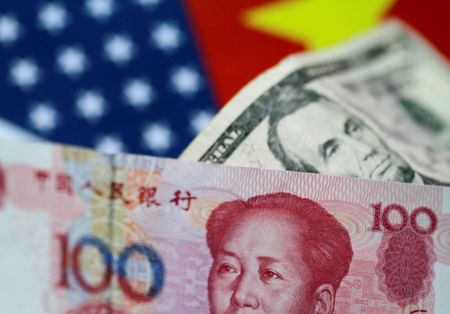Forex
Asia FX rattled by Trump tariff threat as dollar surges; yuan at 4-mth low

Investing.com– The Chinese yuan hit a four-month low against a rallying dollar on Monday as Asian currencies fell sharply on U.S. President-elect Donald Trump’s latest threat to impose hefty tariffs on BRICS nations.
Trump threatened to impose 100% tariffs on BRICS countries – including Brazil, Russia, India, China, and South Africa – in a social media post on Sunday. He vowed of severe economic consequences for any nation attempting to undermine the U.S. dollar’s dominance by backing alternative currencies. His warning, aimed at countries seeking to reduce their reliance on the dollar in global trade, sent ripples through Asian markets, with concerns mounting over potential disruptions in trade relations.
The threat follows Trump’s earlier vow to impose higher tariffs on goods from China, Mexico, and Canada, sparking fears of a renewed trade war between the world’s largest economies. Heightened tensions weighed heavily on sentiment towards risk-driven markets in Asia, denting regional currencies.
The surged 0.5%, while the jumped 0.4%, benefiting from the greenback’s status as a global safe-haven asset.
The South Korean won, and the Japanese yen led losses among Asian currencies, with the pair rising 0.6% and South Korea’s climbing 0.7%.
The Singapore dollar’s pair, and the Thai baht’s pair fell 0.5% each.
The Indian rupee’s pair rose 0.2% to a record high of 84.708 rupees.
The rupee was also pressured by data on Friday that showed that India’s growth slowed in the July-September period compared to the previous quarter. Still, India maintained its status as the world’s fastest-growing major economy, outpacing China’s 4.6% growth during the same period.
China’s yuan under pressure despite strong economic data
The Chinese yuan’s onshore pair rose 0.3% and was at its highest level since late-July, taking little support from positive purchasing managers index data for November.
China’s official for November showed a modest growth, signaling a recovery in factory output, while the private-sector also rose to its highest level since June. The data was seen as a positive sign for the Chinese economy after a barrage of aggressive stimulus measures in the past two months.
However, concerns persist over the impact of rising trade tensions on Chinese exports, which remain sluggish. The yuan weakened 1.8% against the dollar in November, driven by fears of an intensifying U.S.-China trade dispute, especially after Trump’s election victory.
Dollar on the rise as investors look for rate cues; regional data awaited
The dollar started the first day of the week, and the month on an upbeat note, as markets now expect a slower rate cut path by the Federal Reserve, although a quarter percentage cut is widely expected at the Fed’s December meeting. Investors are still looking for more cues on the central bank’s rate outlook.
Fed is set to speak on Wednesday, while key U.S. data for November is also due later in the week.
In Asia Pacific region, the Reserve Bank of India will decide on its on Friday, and is widely expected to keep rates unchanged amid sticky Indian inflation.
Australia is set to release its third-quarter figures on Wednesday.

 Forex3 years ago
Forex3 years agoForex Today: the dollar is gaining strength amid gloomy sentiment at the start of the Fed’s week

 Forex3 years ago
Forex3 years agoUnbiased review of Pocket Option broker

 Forex3 years ago
Forex3 years agoDollar to pound sterling exchange rate today: Pound plummeted to its lowest since 1985

 Forex3 years ago
Forex3 years agoHow is the Australian dollar doing today?

 Cryptocurrency3 years ago
Cryptocurrency3 years agoWhat happened in the crypto market – current events today

 World3 years ago
World3 years agoWhy are modern video games an art form?

 Commodities3 years ago
Commodities3 years agoCopper continues to fall in price on expectations of lower demand in China

 Economy3 years ago
Economy3 years agoCrude oil tankers double in price due to EU anti-Russian sanctions





















